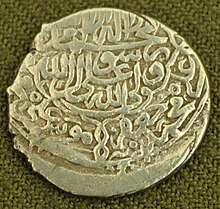Mohammad Chodābande
Mohammad Chodābande or Mohammed Shah (also Khudābanda , Persian شاه محمد خدابنده Shah Mohammad Chodabandeh ; * 1532 ; † 1595 ) was the fourth Safavid Shah of Iranfrom 1577 to 1587. He succeeded his brother Ismail II after his death in 1577 on the throne.
Mohammed Shah was considered mild and ascetic , he was plagued by semi-blindness in his later years. The true power therefore initially came from his wife Mahd-e ʿOlyā and the vizier Mirzā Salmān. In July 1579, however, his wife was murdered , with his consent, in a Kizilbash conspiracy . The Safavid Empire weakened during his rule, especially on the eastern border where Uzbek tribes invaded in 1578. Mohammed Shah lost the favor of the Kizilbasch and had to surrender the throne to his son Hamza Mirza, who, however, died in December 1586 under mysterious circumstances. His younger brother 'Abbās Mirza moved to Qazvin to claim the throne for himself. Mohammed Shah personally crowned his son. After his withdrawal, Mohammed Shah spent the rest of his life in solitude. He died eight years later, and his son brought his body for burial according to Karbala .
War with the Ottomans
The most important event of the reign of Muhammad was a new war with the Ottoman Empire ( Ottoman-Safavid War (1578-1590) ). The Ottoman army, led by Osman Pasha, crossed the Iranian border. The intention of the Ottoman Sultan Murad III. was to bring Transcaucasia with its Sunni majority under his control. With the help of the Crimean Tatars , the Ottomans advanced to Baku and Derbent in 1579 and disrupted the Safavid maritime traffic on the Caspian Sea . In 1585 the Ottomans briefly occupied Tabriz and caused a massacre. Mohammed Shah sent his eldest son Hamza Mirza against the Ottomans. Shortly afterwards, Osman Pasha died in Tabriz, and the young prince decided to cross the border river Aras and attack Ottoman territory. His actions probably led the enemy to make peace and withdraw from Tabriz.
source
- Mohammad Chodābande . In: Ehsan Yarshater (Ed.): Encyclopædia Iranica (English, including references)
| personal data | |
|---|---|
| SURNAME | Mohammad Chodābande |
| ALTERNATIVE NAMES | Mohammed Khodabanda; Mohammad Khudābande; Mohammed Shah Chodabandeh |
| BRIEF DESCRIPTION | Safavid Shah of Iran (1578–1587) |
| DATE OF BIRTH | 1532 |
| DATE OF DEATH | 1595 |
